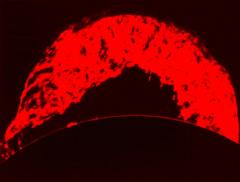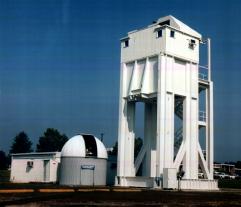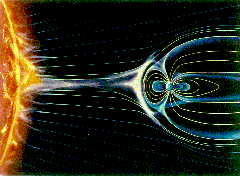 |
Click on image for larger version. |
|
Solar Magnetic Fields
Magnetism is the key to understanding the Sun. Magnetic fields
are produced in the Sun by the flow of electrically charged ions and electrons. Sunspots are places where very intense magnetic lines of force
break through the Sun's surface. The sunspot cycle results from
the recycling of magnetic fields by the flow of material in the interior.
The prominences seen floating above the surface of the Sun are
supported, and threaded through, with magnetic fields. The streamers
and loops seen in the corona are shaped by magnetic fields. Magnetic fields are at the
root of virtually all of the features we see on and above the Sun. Without magnetic fields
the Sun would be a rather boring star.
|
 |
Click on image for larger version. |
|
Measuring Magnetic Fields
Magnetic forces change the direction of motion of moving charged particles
like electrons. Because of this, electrons that orbit around a nucleus in one direction
will have more energy than electrons that orbit about the nucleus in the opposite
direction. This allows us to remotely measure the Sun's magnetic field by observing the
difference in the energy of the light emitted as these electrons jump from orbit to orbit.
With the proper instrumentation we can determine both the
strength and the direction of the magnetic field all across the surface of the Sun.
|
 |
Click on image for larger version. |
|
Modeling Magnetic Fields
Magnetic field lines loop through the solar atmosphere and interior to
form a complicated web of magnetic structures. Many of these structures are visible in the
chromosphere and corona, the outermost
layers of the Sun's atmosphere. However, we usually measure the magnetic field itself in
the photosphere, the innermost layer of the Sun's atmosphere. Techniques can be used to mathematically map these magnetic field
lines into the outer layers where they can be compared with the observed structures.
|
 |
Click on image for larger version. |
|
Predicting Space Weather
A better understanding of the Sun's magnetic field and its behavior will
allow us to make better predictions of space weather.
Observations of magnetic fields associated with solar flares
show that flares are likely to occur when the magnetic field lines linking two sunspots
become sheared or twisted. Observations of the Sun's magnetic
field over the last 20 years illustrates its behavior over two sunspot cycles.
Predicting long-range behavior, such as the size of the sunspot
cycle, is currently based on simplified ideas about the magnetic cycle and previously
observed behavior. We hope that in the near
future we will understand the Sun well enough to make these predictions based on current
conditions and past history using a mathematical model of the actual processes.
|





